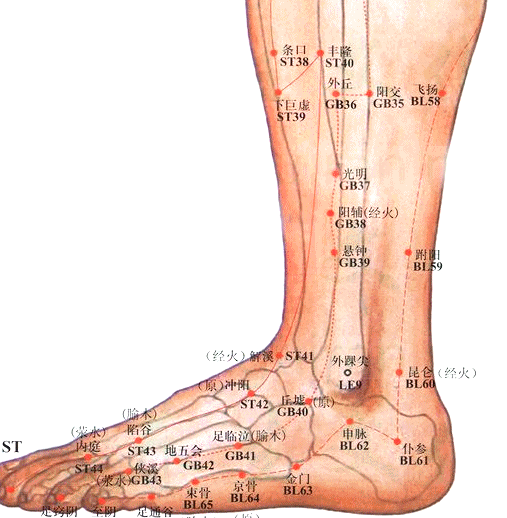Luo vessels are branches that diverge from the main meridians, serving to enhance the connection and regulation between the Yin and Yang of the interior and exterior. Each of the twelve meridians and the Ren and Du meridians has a separate Luo vessel, along with the large Luo of the Spleen, totaling fifteen Luo vessels.
Foot Shaoyang Luo Vessel is one of the fifteen Luo vessels, named Guangming, which branches from the Foot Shaoyang meridian at the Guangming point. It diverges five cun above the ankle joint (Guangming) and travels towards the Foot Jueyin meridian, connecting down to the dorsum of the foot. The conditions associated with this Luo vessel can be categorized into two patterns: the excess pattern is cold limbs; the deficiency pattern is atrophy, which refers to muscle atrophy or weakness, where one is unable to stand up from a seated position.
Needling the Guangming point is indicated for treatment.
【Guangming Point】

Guangming means bright, and this point belongs to the Gallbladder meridian. It is effective in treating eye diseases, restoring vision, hence the name Guangming.
Location: On the lateral side of the lower leg, 5 cun above the tip of the lateral malleolus, at the anterior border of the fibula.
Needling Technique: First locate the external hill (the midpoint of the line connecting the popliteal crease and the tip of the lateral malleolus, then move down 1 transverse finger to find the external hill point), then move down 3 transverse fingers along the anterior border of the fibula to locate the Guangming point.
Functions: Soothe the liver, brighten the eyes, activate the collaterals, reduce swelling, clear heat, and drain fire.
Indications: Conditions of the eyes and lower legs, such as eye pain and itching, night blindness, leg and knee soreness, lower limb weakness, coldness in hands and feet, lower abdominal pain in women, breast pain, migraine, myopia, epilepsy, breast engorgement, cataracts, headache, unclear vision, chest and hypochondriac distension, insufficient lactation. In modern practice, Guangming point is also used to treat conditions like congenital night blindness, optic nerve atrophy, gastrocnemius muscle spasms, blepharitis, refractive errors, mental disorders, knee arthritis, and lumbar sprains.
Needling Method: Insert straight 1 to 1.5 cun.
Moxibustion Method: Moxa stick moxibustion or warm needle moxibustion for 3 to 5 cones, or moxa stick for 10 to 20 minutes.
Massage: Use the tip of the middle finger to press the Guangming point vertically, massaging once in the morning and once in the evening for 1 to 3 minutes each time, which can treat myopia, senile cataracts, glaucoma, and optic nerve diseases.
Combination: Combine with Jingming point, Chengqi point, and Tongziliao point for eye pain.
Combine with Yanglingquan point and Kunlun point for lower limb weakness.
Combine with Ganshu point, Shenshu point, Fengchi point, Mucang point, Jingming point, and Xingjian point for glaucoma and early cataracts.

